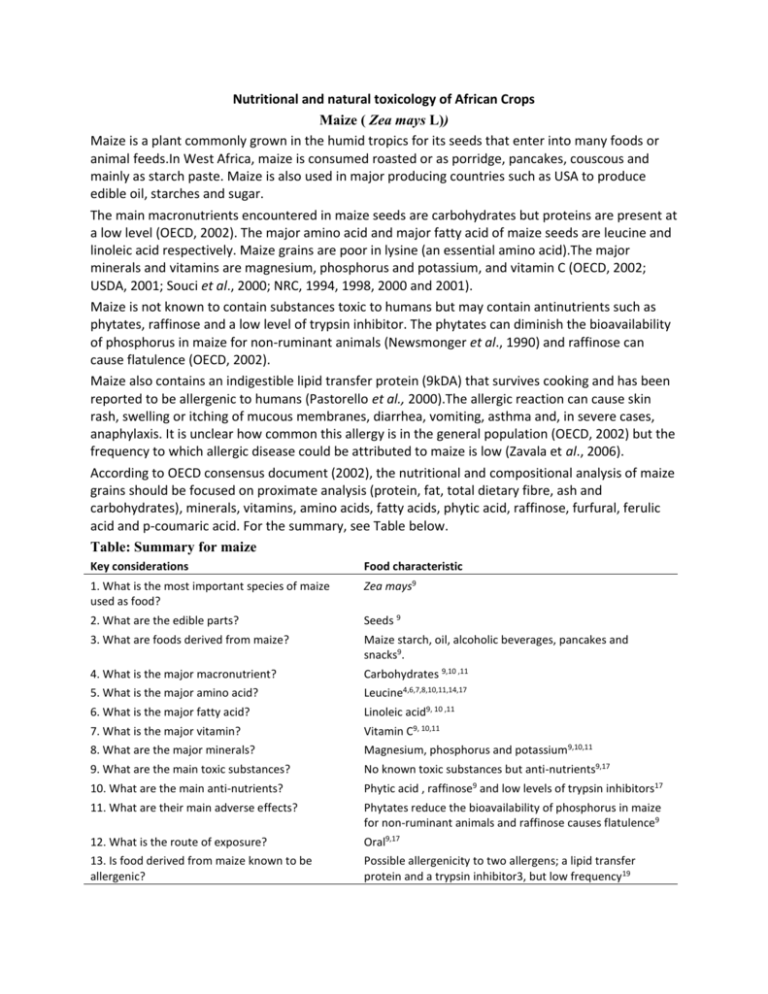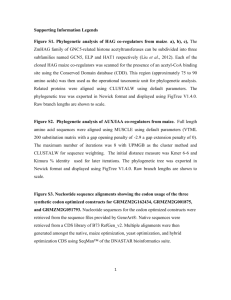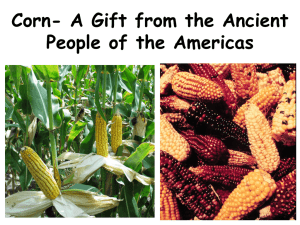Summary of Crop composition – Food Safety Considerations
advertisement

Nutritional and natural toxicology of African Crops Maize ( Zea mays L)) Maize is a plant commonly grown in the humid tropics for its seeds that enter into many foods or animal feeds.In West Africa, maize is consumed roasted or as porridge, pancakes, couscous and mainly as starch paste. Maize is also used in major producing countries such as USA to produce edible oil, starches and sugar. The main macronutrients encountered in maize seeds are carbohydrates but proteins are present at a low level (OECD, 2002). The major amino acid and major fatty acid of maize seeds are leucine and linoleic acid respectively. Maize grains are poor in lysine (an essential amino acid).The major minerals and vitamins are magnesium, phosphorus and potassium, and vitamin C (OECD, 2002; USDA, 2001; Souci et al., 2000; NRC, 1994, 1998, 2000 and 2001). Maize is not known to contain substances toxic to humans but may contain antinutrients such as phytates, raffinose and a low level of trypsin inhibitor. The phytates can diminish the bioavailability of phosphorus in maize for non-ruminant animals (Newsmonger et al., 1990) and raffinose can cause flatulence (OECD, 2002). Maize also contains an indigestible lipid transfer protein (9kDA) that survives cooking and has been reported to be allergenic to humans (Pastorello et al., 2000).The allergic reaction can cause skin rash, swelling or itching of mucous membranes, diarrhea, vomiting, asthma and, in severe cases, anaphylaxis. It is unclear how common this allergy is in the general population (OECD, 2002) but the frequency to which allergic disease could be attributed to maize is low (Zavala et al., 2006). According to OECD consensus document (2002), the nutritional and compositional analysis of maize grains should be focused on proximate analysis (protein, fat, total dietary fibre, ash and carbohydrates), minerals, vitamins, amino acids, fatty acids, phytic acid, raffinose, furfural, ferulic acid and p-coumaric acid. For the summary, see Table below. Table: Summary for maize Key considerations Food characteristic 1. What is the most important species of maize used as food? Zea mays9 2. What are the edible parts? Seeds 9 3. What are foods derived from maize? Maize starch, oil, alcoholic beverages, pancakes and snacks9. 4. What is the major macronutrient? Carbohydrates 9,10 ,11 5. What is the major amino acid? Leucine4,6,7,8,10,11,14,17 6. What is the major fatty acid? Linoleic acid9, 10 ,11 7. What is the major vitamin? Vitamin C9, 10,11 8. What are the major minerals? Magnesium, phosphorus and potassium9,10,11 9. What are the main toxic substances? No known toxic substances but anti-nutrients9,17 10. What are the main anti-nutrients? Phytic acid , raffinose9 and low levels of trypsin inhibitors17 11. What are their main adverse effects? Phytates reduce the bioavailability of phosphorus in maize for non-ruminant animals and raffinose causes flatulence9 12. What is the route of exposure? Oral9,17 13. Is food derived from maize known to be allergenic? Possible allergenicity to two allergens; a lipid transfer protein and a trypsin inhibitor3, but low frequency 19 References 1 Aung L H, Fouse D C, Brandl D G, 1993. Effects of imbibition and modified atmospheres on the soluble sugar content of supersweet corn embryo and endosperm. J. Hort. Sc; 68(1): 37-43. 2 Cambier V, Hance T, De Hoffmann E, 2000. Variation of DIMBOA and related compounds content in relation to the age and plant organ in maize. Phytochemistry; 53: 223-229. 3 Pastorello E A, Farioli L, Pravettoni V, Ispano M, Scibola E, Trambaioli C, Giuffrida MG, Ansaloni R, GodovacZimmermann J, Conti A, Fortunato D, Ortolani C., 2000. The maize major allergen, which is responsible for foodinduced allergic reactions, is a lipid transfer protein. J Allergy Clin. Immunol; 106(4): 744-51. 4 Monsanto, 2000. Safety and nutritional assessment of corn rootworm protected corn event MON 863.U.S. FDA/CFSAN BNF 75 5 Naczk M, Amarowicz R, Shahidi F., 1997. α-Galactosides of sucrose in foods: composition, flatulence-causing effects and removal. In: Anti-nutrients and phytochemical in food. Amer. Chem. Soc. Symposium Series; 662: 12751. 6 National Research Council (NRC), 1994. Nutrient requirements of poultry (Ninth Revised Edition). National Academy Press, Washington D.C., USA. 7 National Research Council (NRC), 1998. Nutrient requirements of swine (Tenth Revised Edition). National Academy Press, Washington D.C., USA. 8 National Research Council (NRC), 2001. Nutrient requirements of dairy cattle (Seventh Revised Edition). National Academy Press, Washington D.C., USA. 9 Organization for Economic Co-operation and Development (OECD), 2002. Consensus Document on Compositional Considerations for new varieties of maize (Zea Mays): Key food and feed nutrients, anti-nutrients and secondary plant metabolites. Series on the Safety of Novel Foods and Feeds No.6. 10 Souci S W, Fachmann W, Kraut H. Food composition and nutrition tables, 6th ed., 2000. Med. Pharm Scientific Publishers - CRC press, Stuttgart, Germany, 2000. 11 Unites States Department of Agriculture, Agricultural Research Service, 2001. USDA Nutrient Database for Standard Reference, Release 14. 12 United States Department of Agriculture, 2013. World agricultural supply and demand estimates-515. World food Agricultural board. ISSN: 1554-9089 13 Voragen AGJ, 1998.Technological aspects of functional food-related carbohydrates. Trends in Food Science and Technologie.; 9 (8-9) : 328-335. 14 Watson SA, 1982. Corn, amazing maize, general properties. pp 3-29. In: Wolff IA (Ed.) CRC Handbook of processing and utilization in agriculture, Vol. II, Part I, Plant Products. CRC Press, Inc, Florida. 15 Watson SA, 1987. Structure and composition. pp 53-80 In: Watson SA and Ramstad RE (Eds.), Corn chemistry and Technology, Amer. Soc. Cereal Chem. Inc. St Paul, Minnesota. 17 White PJ and Pollak LM, 1995. Corn as a food source in the United States: Part II. Processes, products, composition and nutritive values. Cereal Foods World; 40 (10): 756-762. 18 Xie Y, Arnason JT, Philogene BJR, Olechowski HT, Hamilton RI, 1992. Variation in hydroxamic acid content in maize roots in relation to geographic origin of maize germplasm and resistance to Western corn rootworm (Coleoptera: Chrysomelidae). Journal of Economic Entomology; 85: 2478-2485. 19 Zavala VMP, Vega Robledo GB, Sánchez Olivas MA, Duarte Diaz RJ, Oviedo CL., 2006. Maize (Zea mays): allergen or toleragen? Participation of the cereal in allergic disease and positivity incidence in cutaneous tests. Rev. Allerg. Mex; 53(6): 207-11 Lassina Ouattara 2013







